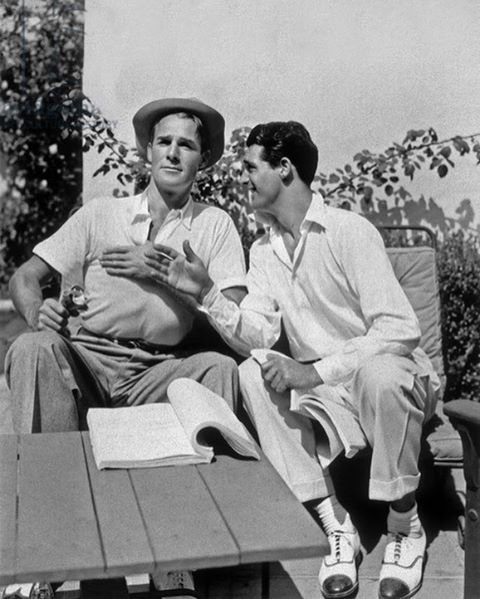 Yes, the global gay conspiracy has had one of its early successes in the city of Palm Springs. It may be the one city in the US where restaurants and clubs can be referred to as “straight-friendly.”
Yes, the global gay conspiracy has had one of its early successes in the city of Palm Springs. It may be the one city in the US where restaurants and clubs can be referred to as “straight-friendly.”
Recently, Palm Springs received media attention as being the only city in the U.S. with an all-LGBT city council. All five elected members trouped up to Sacramentoto receive official recognition from the state legislature. Indeed, Palm Springs has more gay couples per household than any city in the U.S.
How did the city become such a gay mecca? The truth is that Palm Springs was always a place for privacy; for people, including gay people, to be themselves, away from the constraints of so-called “acceptable behavior.”
A Remedy for Hollywood
It is well known that Palm Springs was a haven for Hollywood celebrities, because of its culture of privacy and its just-far-enough distance from the gossip and glare of Hollywood. Studios had a rule that their stars had to be within two hours of Hollywood, and in those days, Palm Springs was a quick drive or train ride away. The city was a little like Las Vegas bills itself today: What happens in Palm Springs, stays in Palm Springs.
As far back as its founding, Palm Springs attracted free-spirited, independent thinkers. Hotels and homes with high walls and hedges kept out prying eyes and created an anything-goes atmosphere. Among the first permanent, white settlers included Dr. Florilla White, her sister Cornelia, and Lois Kellogg, women who would have been considered notorious in “polite” society of the early twentieth century. The Whites entertained the likes of Rudolf Valentino at their Palm Springs Hotel, while Kellogg built her mansion with high walls and multiple cottages to accommodate guests of all persuasions.
In the 30s, Greta Garbo, known for her nearly obsessive privacy, was a regular visitor to the desert, often accompanied by her lesbian “friend,” writer Mercedes de Acosta. Palm Springs was developing into a celebrity hangout, where the locals simply accepted them.
Hollywood loathed gay men and required its leading men to date and marry female stars. They would be seen in public and photographed with women for the fan magazines in and around Hollywood, and then come out to Palm Springs to relax and unwind. Cary Grant, married multiple times, had a picturesque relationship with his Movie Colony neighbor, Randolph Scott. Rock Hudson and Tab Hunter frequented the desert, pose poolside with female starlets for photographers, and then retreat into private homes —and lives, away from the cameras.
Rumor and innuendo abound about these stars, but Palm Springs allowed them to keep their private life private. So, except for a few cases, rumor and innuendo was all that there was. One celebrity who made Palm Springs his primary residence, Liberace, pretty much defied ambiguity with his flamboyance, and yet maintained that he was not gay until his death from AIDS. He had several estates in Palm Springs during his life, which have become stops on celebrity tours of the city.
Out of the Closet and into the Desert
Palm Springs wasn’t just the perfect spot for closeted gay celebrities, it started to attract other gay people from around the country, who were also unable to come out at home and wanted a vacation spot where they could be themselves. The city leaders weren’t so fond of this at first, and “encouraged” the gay community to open its establishments in nearby Cathedral City. But after Palm Springs went through a marked decline in the 70s, it slowly warmed up to the idea, especially as gay men brought money to renovate and revitalize a deteriorating neighborhood, Warm Sands, and create a gay resort town within a town.
By the 90s, Palm Springs was undergoing a renaissance. The city filled up with gay and lesbian visitors; events, like the White Party and Club Skirts Dinah Shore Weekend, brought even more gay tourists. Soon, these tourists discovered a virtual treasure trove of nearly untouched, inexpensive, sometimes abandoned architectural gems from the 50s and 60s. The nostalgia for midcentury anything was booming, and, without making too much out of a stereotype, gay men with design sense and money flocked here to remodel to their hearts’ content and live either full time or seasonally, or use these second homes for a quick get-away.
It’s no secret that gay men’s health plays a role in making Palm Springs a welcoming place for, if not retirement, then at least slowing down and getting out of the urban rat race. Many gay couples found they could sell their property in the city and pay cash for a home in the desert. The growing gay population brought with it a need for the specialized health care many gay men could only get in large urban centers. One would be hard pressed to find another town of roughly 40,000 people with as many medical specialists and services dedicated to those living with HIV/AIDS. In Palm Springs, gay men can find a close-knit, supportive community that promotes health and well-being.
With so many gay people moving here from cities such as San Francisco, Seattle and Chicago, Palm Springs has acquired an urban sophistication that you don’t find in other resort and retirement communities. And that has led to an explosion in the arts, design, fine dining and high-end hotels that appeal to young, hip urbanites.
High walls and ficus hedges still sequester many homes and resorts in Palm Springs, but gay people are not hidden anymore. As evidenced by the make up of the city council alone, they have become a defining part of the larger, diverse desert community.
Posted by Geoffrey Moore on
Leave A Comment